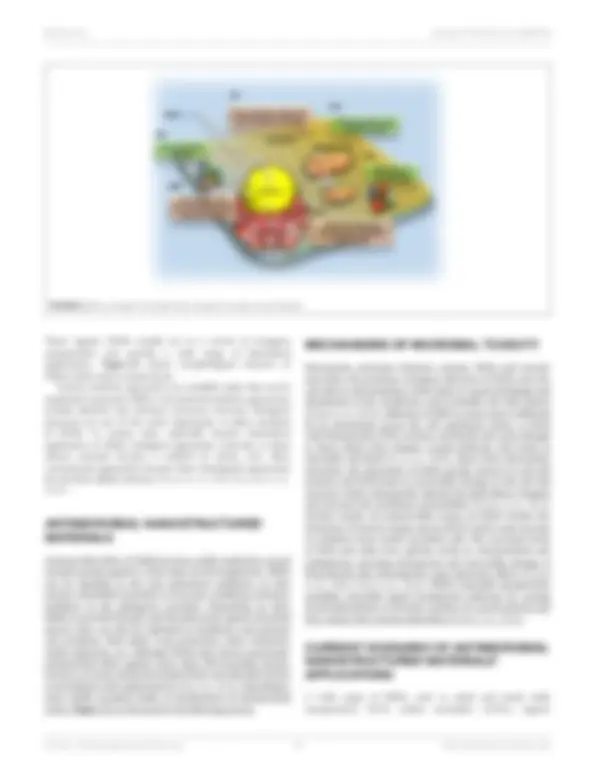








Estude fácil! Tem muito documento disponível na Docsity

Ganhe pontos ajudando outros esrudantes ou compre um plano Premium


Prepare-se para as provas
Estude fácil! Tem muito documento disponível na Docsity
Prepare-se para as provas com trabalhos de outros alunos como você, aqui na Docsity
Os melhores documentos à venda: Trabalhos de alunos formados
Prepare-se com as videoaulas e exercícios resolvidos criados a partir da grade da sua Universidade
Responda perguntas de provas passadas e avalie sua preparação.

Ganhe pontos para baixar
Ganhe pontos ajudando outros esrudantes ou compre um plano Premium
Comunidade
Peça ajuda à comunidade e tire suas dúvidas relacionadas ao estudo
Descubra as melhores universidades em seu país de acordo com os usuários da Docsity
Guias grátis
Baixe gratuitamente nossos guias de estudo, métodos para diminuir a ansiedade, dicas de TCC preparadas pelos professores da Docsity
Nanostructured materials (NSMs) have increasingly been used as a substitute for antibiotics and additives in various products to impart microbicidal effect. In particular, use of silver nanoparticles (AgNPs) has garnered huge researchers’ attention as potent
Tipologia: Trabalhos
1 / 10

Esta página não é visível na pré-visualização
Não perca as partes importantes!







published: 09 March 2018 doi: 10.3389/fmicb.2018.
Edited by: Arunas Ramanavicius, Vilnius University, Lithuania Reviewed by: Umme Thahira Khatoon, National Institute of Technology Warangal, India M. Oves, King Abdulaziz University, Saudi Arabia
*Correspondence: Pradeep Kumar pkbiotech@gmail.com Pranjal Chandra pchandra13@iitg.ernet.in; pranjalmicro13@gmail.com
Specialty section: This article was submitted to Antimicrobials, Resistance and Chemotherapy, a section of the journal Frontiers in Microbiology Received: 10 September 2017 Accepted: 22 February 2018 Published: 09 March 2018 Citation: Baranwal A, Srivastava A, Kumar P, Bajpai VK, Maurya PK and Chandra P (2018) Prospects of Nanostructure Materials and Their Composites as Antimicrobial Agents. Front. Microbiol. 9:422. doi: 10.3389/fmicb.2018.
(^1) Department of Biosciences and Bioengineering, Indian Institute of Technology Guwahati, Guwahati, India, 2 Department of Pharmacology and Toxicology, National Institute of Pharmaceutical Education and Research, Guwahati, India, 3 Department of Forestry, North Eastern Regional Institute of Science and Technology, Deemed University, Nirjuli, India, 4 Department of Energy and Materials Engineering, Dongguk University-Seoul, Seoul, South Korea, 5 Interdisciplinary Laboratory of Clinical Neuroscience (LiNC), Department of Psychiatry, Universidade Federal de São Paulo-UNIFESP, São Paulo, Brazil
Nanostructured materials (NSMs) have increasingly been used as a substitute for antibiotics and additives in various products to impart microbicidal effect. In particular, use of silver nanoparticles (AgNPs) has garnered huge researchers’ attention as potent bactericidal agent due to the inherent antimicrobial property of the silver metal. Moreover, other nanomaterials (carbon nanotubes, fullerenes, graphene, chitosan, etc.) have also been studied for their antimicrobial effects in order ensure their application in widespread domains. The present review exclusively emphasizes on materials that possess antimicrobial activity in nanoscale range and describes their various modes of antimicrobial action. It also entails broad classification of NSMs along with their application in various fields. For instance, use of AgNPs in consumer products, gold nanoparticles (AuNPs) in drug delivery. Likewise, use of zinc oxide nanoparticles (ZnO-NPs) and titanium dioxide nanoparticles (TiO 2 -NPs) as additives in consumer merchandises and nanoscale chitosan (NCH) in medical products and wastewater treatment. Furthermore, this review briefly discusses the current scenario of antimicrobial nanostructured materials (aNSMs), limitations of current research and their future prospects. To put various perceptive insights on the recent advancements of such antimicrobials, an extended table is incorporated, which describes effect of NSMs of different dimensions on test microorganisms along with their potential widespread applications.
Keywords: nanostructured material, antimicrobial activity, cytotoxicity, human health, antimicrobial agent
FIGURE 1 | (i) Illustration representing classification of nanostructured materials used as antimicrobials and (ii) depiction of various forms of nanostructured materials and their morphology.
CLASSIFICATION OF NANOSTRUCTURED MATERIALS
Metal/Metal Oxide Nanoparticles
Fullerenes, Graphene, and Carbon Nanotubes
Different nanostructured materials and composites with their antimicrobial effect against selected strains and potential applications in different fields.
Nanostructured materials andcomposites
Size/diameter
(nm)
Test microbial organisms
Effect of nanostructured material
Potential industrial applications
References
ZnO nano needle
ca. 63
Escherichia coli, Bacillus subtilis, and
Aspergillus niger
Successful inhibition of test microbes wasobserved
Functional building material
Singh et al., 2018
Nano-liposomal formulation ofmupirocin
Neisseria gonorrhoeae
Highly efficacious antibacterial activity wasobserved
Next generation antibiotics
Cern et al., 2018
Chitosan (CS) functionalizedpolyaniline-polypyrrole copolymer
E. coli and E. agglomerans
Excellent antimicrobial activity againstbacterial strains
Biomedical devices, water filters, andinstrument preparation
Kumar et al., 2017
Graphene oxide-chitosan (CS-GO)nanocomposite
E. coli and B. subtilis
Efficient bacterial inactivation wasobserved
Food packaging
Grande et al., 2017
Polypyrole/Cu-doped ZnOnanocomposite
E. coli and B. subtilis
Successful inhibition of test microbes wasobserved
Environmental pollution monitoring
Khan et al., 2017
ZnO-NP coated cotton composites
E. coli, S. aureus, C. albicans,and Microsporum canis
Successful inhibition of test microbes wasobserved
Textile industry
El-Nahhal et al., 2017
Fe
-NPs 3
Bacillus cereus and Klebsiellapneumonia
High antibacterial activity was evident
Antimicrobial and biomedical applications
Ansari et al., 2017
AgNPs
E. coli, B. subtilis, S. cerevisiae,and C. albicans
Highest sensitivity was evident for
E. coli,
S. cerevisiae, and C. albicans
Textile industry
Khatoon et al., 2017
ZnO-ZnS@polyaniline nanocomposite
E. coli
High antibacterial activity was evident
Waste water treatment
Anjum et al., 2017
AgNPs
E. coli and S. aureus
Diminished bacterial growth was evident
Portable water filters, medical devices,food packaging, clothing, washingmachine and refrigerator coating, andstorage containers
Andrade et al., 2016
AgNPs
Candida albicans
Successful inhibition of growth of
albicans
Antifungal medication against urinary tractinfection (UTI)
Oves et al., 2016
Hydroxyapatite—AgNP composite
E. coli and S. aureus
Effective inhibition of bacterial strains evenat low concentrations of AgNPs
Medical implants and dental applications
Andrade et al., 2016
Cobalt doped ZnO-NP
Shigella dysenteriae, Salmonellatyphi, Vibrio cholerae and E. coli
Effective bactericidal effect against
Vibrio
cholerae and E. coli was observed
Waste water treatment
Oves et al., 2015
PEGylated Ag- Graphene quantumdots (GQDs) nanocomposite
P. aeruginosa
and
S. aureus
Synergistic antibacterial effect of AgNPand GQD was observed
Next generation antibiotics
Habiba et al., 2015
AuNP stabilized liposome
S. aureus
Successful antibacterial action was evident
Antibacterial agent and Drug delivery
Gao et al., 2014
Methicillin-resistant
S. aureus
and E. coli
Selective antibacterial photodynamiceffect of GQD was evident
Next generation antibiotics
Ristic et al., 2014
AgNP-graphene oxide (GO)Nano-sheets composite
S. aureus
and
B. subtilis
Nanocomposite resulted in complete lossof bacterial stains
Next generation antibiotics
Das et al., 2013
AuNPs
Puccinia graminis tritci, A. flavus,A. niger
and
C. albicans
Effective inhibition of test fungal strainswas evident
Antifungal medication
Jayaseelan et al., 2013
AgNPs wrapped in carbon (GO)nano-scrolls (composite)
C. albicans
and
C. tropicalis
Prolonged and enhanced antifungalactivity was evident for nano-scrolls
Next generation antibiotics, medical, andhealth care products
Li et al., 2013
CuNP
C. albicans
Strong antifungal activity was evident
Dental materials
Usman et al., 2013
ZnO-NP
25 and 40
S. aureus, S. marcescens,
and
mirabilis
Prominent inhibition of the bacterial strains
Antimicrobial creams, lotions andointments, sunscreen lotions, deodorants,ceramics, and self-cleaning glass
Gunalan et al., 2012
(Continued)
Nanoscale Chitosan (NCH)
Organic Nanoparticles
LIMITATIONS OF PRESENT WORK AND FUTURE PROSPECTS OF aNSMs
CONCLUSIONS
AUTHOR CONTRIBUTIONS
ACKNOWLEDGMENTS
REFERENCES
Abdel-Raouf, N., Al-Enazi, N. M., and Ibraheem, I. B. (2017). Green biosynthesis of gold nanoparticles using Galaxaura elongata and characterization of their antibacterial activity. Arab. J. Chem. 10, S3029–S3039. doi: 10.1016/j.arabjc.2013.11. Ahmed, S., Ahmad, M., Swami, B. L., and Ikram, S. (2016). A review on plants extract mediated synthesis of silver nanoparticles for antimicrobial applications: a green expertise. J. Adv. Res. 7, 17–28. doi: 10.1016/ j.jare.2015.02. Akhavan, O., Azimirad, R., Safa, S., and Larijani, M. (2010). Visible light photo- induced antibacterial activity of CNT–doped TiO 2 thin films with various CNT contents. J. Mater. Chem. 20, 7386–7392. doi: 10.1039/c0jm00543f Andrade, F. A. C., De Oliveira Vercik, L. C., Monteiro, F. J., and Da Silva Rigo, E. C. (2016). Preparation, characterization and antibacterial properties of silver nanoparticles–hydroxyapatite composites by a simple and eco-friendly method. Ceram. Int. 42, 2271–2280. doi: 10.1016/j.ceramint.2015.10. Anjum, M., Oves, M., Kumar, R., and Barakat, M. (2017). Fabrication of ZnO- ZnS@ polyaniline nanohybrid for enhanced photocatalytic degradation of 2-chlorophenol and microbial contaminants in wastewater. Int. Biodeterior. Biodegrad. 119, 66–77. doi: 10.1016/j.ibiod.2016.10. Ansari, S. A., Oves, M., Satar, R., Khan, A., Ahmad, S. I., Jafri, M. A., et al. (2017). Antibacterial activity of iron oxide nanoparticles synthesized by co- precipitation technology against Bacillus cereus and Klebsiella pneumoniae. Polish J. Chem. Tech. 19, 110–115. doi: 10.1515/pjct-2017- Armentano, I., Arciola, C. R., Fortunati, E., Ferrari, D., Mattioli, S., Amoroso, C. F., et al. (2014). The interaction of bacteria with engineered nanostructured polymeric materials: a review. Sci. World J. 2014, 1–18. doi: 10.1155/2014/ Arokiyaraj, S., Saravanan, M., Prakash, N. U., Arasu, M. V., Vijayakumar, B., and Vincent, S. (2013). Enhanced antibacterial activity of iron oxide magnetic nanoparticles treated with Argemone mexicana L. leaf extract: an in vitro study. Mat. Res. Bull. 48, 3323–3327. doi: 10.1016/j.materresbull.2013.05. Azam, A., Ahmed, A. S., Oves, M., Khan, M. S., and Memic, A. (2012). Size-dependent antimicrobial properties of CuO nanoparticles against gram- positive and-negative bacterial strains. Int. J. Nanomed. 7, 3527-3535. doi: 10.2147/IJN.S Baranwal, A., Mahato, K., Srivastava, A., Maurya, P. K., and Chandra, P. (2016). Phytofabricated metallic nanoparticles and their clinical applications. RSC Adv. 6, 105996–106010. doi: 10.1039/C6RA23411A Beyth, N., Houri-Haddad, Y., Domb, A., Khan, W., and Hazan, R. (2015). Alternative antimicrobial approach: nano-antimicrobial materials. Evid. Based Complement. Alternat. Med. 2015, 1–16. doi: 10.1155/2015/ Bhushan, B. (2010). Springer Handbook of Nanotechnology. Berlin; Heidelberg: Springer Science & Business Media. Bogdanovi´c, U., Lazi´c, V., Vodnik, V., Budimir, M., Markovi´c, Z., and Dimitrijevi´c, S. (2014). Copper nanoparticles with high antimicrobial activity. Mater. Lett. 128, 75–78. doi: 10.1016/j.matlet.2014.04. Calabretta, M. K., Kumar, A., McDermott, A. M., and Cai, C. (2007). Antibacterial activities of poly (amidoamine) dendrimers terminated with amino and poly (ethylene glycol) groups. Biomacromolecules 8, 1807–1811. doi: 10.1021/bm Cern, A., Connolly, K. L., Jerse, A. E., and Barenholz, Y. (2018). In vitro susceptibility of Neisseria gonorrhoeae strains to mupirocin. an antibiotic reformulated to parenteral nano-liposomal antibiotic. Antimicrob. Agents Chemother. doi: 10.1128/AAC.02377-17. [Epub ahead of print]. Chen, C. Z., and Cooper, S. L. (2002). Interactions between dendrimer biocides and bacterial membranes. Biomaterials 23, 3359–3368. doi: 10.1016/S0142-9612(02)00036- Cheng, J., Teply, B. A., Sherifi, I., Sung, J., Luther, G., Gu, F. X., et al. (2007). Formulation of functionalized PLGA–PEG nanoparticles for in vivo targeted drug delivery. Biomaterials 28, 869–876. doi: 10.1016/ j.biomaterials.2006.09. Cui, Y., Zhao, Y., Tian, Y., Zhang, W., Lü, X., and Jiang, X. (2012). The molecular mechanism of action of bactericidal gold nanoparticles on Escherichia coli. Biomaterials 33, 2327–2333. doi: 10.1016/j.biomaterials.2011.11. Dakal, T. C., Kumar, A., Majumdar, R. S., and Yadav, V. (2016). Mechanistic basis of antimicrobial actions of silver nanoparticles. Front. Microbiol. 7:1831. doi: 10.3389/fmicb.2016.
Das, M. R., Sarma, R. K., Borah, S. C., Kumari, R., Saikia, R., Deshmukh, A. B., et al. (2013). The synthesis of citrate-modified silver nanoparticles in an aqueous suspension of graphene oxide nanosheets and their antibacterial activity. ?Colloids Surf. B 105, 128–136. doi: 10.1016/j.colsurfb.2012.12. Dastjerdi, R., Mojtahedi, M., Shoshtari, A., and Khosroshahi, A. (2010). Investigating the production and properties of Ag/TiO2/PP antibacterial nanocomposite filament yarns. J. Text. Inst. 101, 204–213. doi: 10.1080/ Dastjerdi, R., and Montazer, M. (2010). A review on the application of inorganic nano-structured materials in the modification of textiles: focus on anti-microbial properties. Colloids Surf. B 79, 5–18. doi: 10.1016/j. colsurfb.2010.03. Desselberger, U. (2000). Emerging and re-emerging infectious diseases. J. Infect. 40, 3–15. doi: 10.1053/jinf.1999. Dinali, R., Ebrahiminezhad, A., Manley-Harris, M., Ghasemi, Y., and Berenjian, A. (2017). Iron oxide nanoparticles in modern microbiology and biotechnology. Crit. Rev. Microbiol. 43, 493–507. doi: 10.1080/1040841X.2016. Dizaj, S. M., Lotfipour, F., Barzegar-Jalali, M., Zarrintan, M. H., and Adibkia, K. (2014). Antimicrobial activity of the metals and metal oxide nanoparticles. Mater. Sci. Eng. C 44, 278–284. doi: 10.1016/j.msec.2014.08. Duncan, T. V. (2011). Applications of nanotechnology in food packaging and food safety: barrier materials, antimicrobials and sensors. J. Colloid Interface Sci. 363, 1–24. doi: 10.1016/j.jcis.2011.07. El-Nahhal, I. M., Elmanamah, A.A., El Ashgar, N. M., Amara, N., Selmane, M., and Chehimi, M. M. (2017). Stabilization of nano-structured ZnO particles onto the surface of cotton fibers using different surfactants and their antimicrobial activity. Ultrason. Sonochem. 38, 478–487. doi: 10.1016/j.ultsonch.2017.03. Espitia, P. J. P., Soares, N. D. F. F., Dos Reis Coimbra, J. S., De Andrade, N. J., Cruz, R. S., and Medeiros, E. A. A. (2012). Zinc oxide nanoparticles: synthesis, antimicrobial activity and food packaging applications. Food Bioprocess Tech. 5, 1447–1464. doi: 10.1007/s11947-012-0797- Gao, W., Vecchio, D., Li, J., Zhu, J., Zhang, Q., Fu, V., et al. (2014). Hydrogel containing nanoparticle-stabilized liposomes for topical antimicrobial delivery. ACS Nano 8, 2900–2907. doi: 10.1021/nn500110a Ghosh, S., Patil, S., Ahire, M., Kitture, R., Kale, S., Pardesi, K., et al. (2012). Synthesis of silver nanoparticles using Dioscorea bulbifera tuber extract and evaluation of its synergistic potential in combination with antimicrobial agents. Int. J. Nanomed. 7, 483-496. doi: 10.2147/IJN.S Grande, C. D., Mangadlao, J., Fan, J., De Leon, A., Delgado-Ospina, J., Rojas, J. G., et al. (2017). “Chitosan cross-linked graphene oxide nanocomposite films with antimicrobial activity for application in food industry,” in Macromolecular Symposia (Weinheim: Wiley Online Library). Gu, F., Zhang, L., Teply, B. A., Mann, N., Wang, A., Radovic-Moreno, A. F., et al. (2008). Precise engineering of targeted nanoparticles by using self-assembled biointegrated block copolymers. Proc. Natl. Acad. Sci. U.S.A. 105, 2586–2591. doi: 10.1073/pnas. Gunalan, S., Sivaraj, R., and Rajendran, V. (2012). Green synthesized ZnO nanoparticles against bacterial and fungal pathogens. Prog. Nat. Sci. Mater. Int. 22, 693–700. doi: 10.1016/j.pnsc.2012.11. Habiba, K., Bracho-Rincon, D. P., Gonzalez-Feliciano, J. A., Villalobos-Santos, J. C., Makarov, V. I., Ortiz, D., et al. (2015). Synergistic antibacterial activity of PEGylated silver–graphene quantum dots nanocomposites. Appl. Mater. Today 1, 80–87. doi: 10.1016/j.apmt.2015.10. Haghighi, N., Abdi, Y., and Haghighi, F. (2011). Light-induced antifungal activity of TiO 2 nanoparticles/ZnO nanowires. Appl. Surf. Sci. 257, 10096–10100. doi: 10.1016/j.apsusc.2011.06. Huang, Z., Zheng, X., Yan, D., Yin, G., Liao, X., Kang, Y., et al. (2008). Toxicological effect of ZnO nanoparticles based on bacteria. Langmuir 24, 4140–4144. doi: 10.1021/la Jayaseelan, C., Ramkumar, R., Rahuman, A. A., and Perumal, P. (2013). Green synthesis of gold nanoparticles using seed aqueous extract of Abelmoschus esculentus and its antifungal activity. Ind. Crops Prod. 45, 423–429. doi: 10.1016/j.indcrop.2012.12. Jilani, A., Othman, M. H. D., Ansari, M. O., Oves, M., Alshahrie, A., Khan, I. U., et al. (2018). A simple route to layer-by-layer assembled few layered graphene oxide nanosheets: optical, dielectric and antibacterial aspects. J. Mol. Liq. doi: 10.1016/j.molliq.2018.01.042. [Epub ahead of print]. Jin, T., Sun, D., Su, J. Y., Zhang, H., and Sue, H. J. (2009). Antimicrobial efficacy of zinc oxide quantum dots against Listeria monocytogenes,
Zhang, L., Pornpattananangku, D., Hu, C. M., and Huang, C. M. (2010). Development of nanoparticles for antimicrobial drug delivery. Curr. Med. Chem. 17, 585–594. doi: 10.2174/ Zhang, Y., Peng, H., Huang, W., Zhou, Y., and Yan, D. (2008). Facile preparation and characterization of highly antimicrobial colloid Ag or Au nanoparticles. J. Colloid Interface Sci. 325, 371–376. doi: 10.1016/j.jcis.2008.05. Zheng, K., Setyawati, M. I., Leong, D. T., and Xie, J. (2017). Antimicrobial gold nanoclusters. ACS Nano 11, 6904–6910. doi: 10.1021/acsnano.7b Zhu, J., Wang, J., Hou, J., Zhang, Y., Liu, J., and Van Der Bruggen, B. (2017). Graphene-based antimicrobial polymeric membranes: a review. J. Mater. Chem. A 5, 6776–6793. doi: 10.1039/C7TA00009J
Conflict of Interest Statement: The authors declare that the research was conducted in the absence of any commercial or financial relationships that could be construed as a potential conflict of interest.
Copyright © 2018 Baranwal, Srivastava, Kumar, Bajpai, Maurya and Chandra. This is an open-access article distributed under the terms of the Creative Commons Attribution License (CC BY). The use, distribution or reproduction in other forums is permitted, provided the original author(s) and the copyright owner are credited and that the original publication in this journal is cited, in accordance with accepted academic practice. No use, distribution or reproduction is permitted which does not comply with these terms.